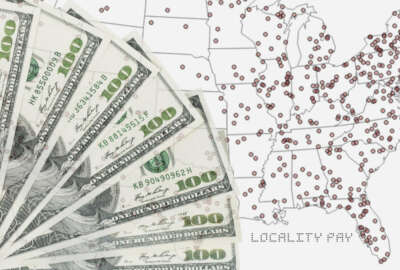As agencies face budget uncertainty, Democrats propose a 7.4% pay raise for feds
Democrats are once again turning their attention to next year’s federal pay raise, but under the current continuing resolution, many agencies are trying to figure...
After federal employees saw their first paychecks with a 5.2% raise this year, House and Senate Democrats are once again turning their attention to next year’s federal pay raise.
But under a continuing resolution that’s now funding the government well into 2024, many agencies are trying to figure out how to fund the already higher pay rates for their employees.
Still, in what’s become an annual tradition, Rep. Gerry Connolly (D-Va.) and Sen. Brian Schatz (D-Hawaii) reintroduced the Federal Adjustment of Income Rates (FAIR) Act in the House and Senate Tuesday. If enacted, the FAIR Act would give most civilian federal employees a 7.4% average pay raise next year. The legislation accounts for a 4% across-the-board raise, plus an average of a 3.4% locality pay adjustment.
The two lawmakers, alongside dozens of Democrat co-sponsors, said a hefty raise for federal employees is only fair given past years of pay freezes, government shutdowns and sequestration cuts.
“Whether inspecting our food, conducting medical research or caring for our veterans, federal workers play an important role in our everyday lives and deserve pay which reflects that,” Schatz said in a statement Tuesday.
Although bicameral Democrats push for the FAIR Act’s passage each year, Congress has never acted on any version of the legislation. Typically, the enacted pay raise for federal employees is lower than what’s included in the FAIR Act. For instance, in 2023, the FAIR Act proposed an 8.7% raise, but the actual raise feds received was 5.2% on average.
For years, federal pay raises have mostly stemmed from presidents’ alternative pay plans, but Congress has occasionally legislated raise amounts for civilian feds. Regardless, the funding for a federal pay raise — whether specified in legislation or authorized by the president — inevitably comes from congressional appropriations.
But under a continuing resolution, agencies’ budgets remain stagnant, while other budget costs, such as federal employees’ paychecks, continue to rise.
“That’s another reason why passing full-year appropriations, rather than a continuing resolution, is critical. Doing so allows Congress to provide adequate budget authority to cover the pay raise,” said John Hatton, a staff vice president at the National Active and Retired Federal Employees Association (NARFE), in an email to Federal News Network. “Continuing resolutions keep past funding decisions static, without regard to increased costs — whether that’s from employee compensation, contract obligations or any other changing circumstance.”
The Centers for Medicare and Medicaid Services (CMS), as an example, has not had a substantive increase in its baseline funding for years. Because of that, CMS has to figure out how to deal with the extra funding needed for the pay raise while operating under a continuing resolution, said Marc Richardson, CMS’ director for marketplace innovation and technology group, at an AFCEA Bethesda Health IT event Tuesday.
Connolly and Schatz’s reintroduction of the FAIR Act marks 10 years in a row of Democrats’ push for a larger raise for civilian feds. The lawmakers, with the support of numerous federal unions and advocacy organizations, said the FAIR Act would help bring federal salaries in line with those of the private sector.
During 2023, federal employees’ pay lagged about 27.5% behind that of private sector workers, the Federal Salary Council reported.
“The FAIR Act is an important step in addressing that gap,” Doreen Greenwald, national president of the National Treasury Employees Union, said in a statement. “By making the federal government a more competitive option for skilled workers, federal agencies can recruit and retain the employees necessary to better serve the American people.”
Pay satisfaction among federal employees is also dwindling. Currently, 57% of feds say they’re happy with their pay — a 10% decline in just the last three years, according to the results of the Federal Employee Viewpoint Survey (FEVS) from the Office of Personnel Management.
“Pay increases for 2024 were not enough to offset rising inflation and the widened federal-private pay deficit,” Randy Erwin, national president of the National Federation of Federal Employees, said in a statement. “Congress must understand that to attract and retain a skilled workforce that best serves the American people, we need to pay our civil servants competitive wages.”
For the FAIR Act, lawmakers calculated the proposed raise percentage through a combination of the Employee Cost Index (ECI) and inflation levels over the last year. The Bureau of Labor Statistics’ ECI measures how much private sector wages grow over time.
There is legal precedent for these calculations. Under the 1990 Federal Employee Pay Comparability Act (FEPCA), the government can provide a base pay raise equal to the ECI from the second quarter of the previous year, minus a half percent. Since the ECI was 4.5% during 2023, the FAIR Act includes a base raise of 4%.
On top of the proposed 4% base pay raise, the 3.4% proposed locality adjustment in the FAIR Act aligns with rates of inflation during 2023.
Although FEPCA would technically allow for that amount, no president since 1994 has implemented the full raise that the law authorizes. Instead, presidents in most years have signed off on an alternative pay plan with a lower raise amount, usually pointing to budget constraints and economic uncertainty as reasons for the alternative.
A recent Federal News Network data dive showed that federal pay raises have lagged behind the private sector’s pay rates, as measured by the ECI, for more than a decade.
It will likely take until March to determine the Biden administration’s thinking for a pay raise in 2025. When the White House releases its annual budget proposal, it may give an indication for what the pay plan will be for next year for civilian federal employees.
Copyright © 2025 Federal News Network. All rights reserved. This website is not intended for users located within the European Economic Area.
Drew Friedman is a workforce, pay and benefits reporter for Federal News Network.
Follow @dfriedmanWFED






